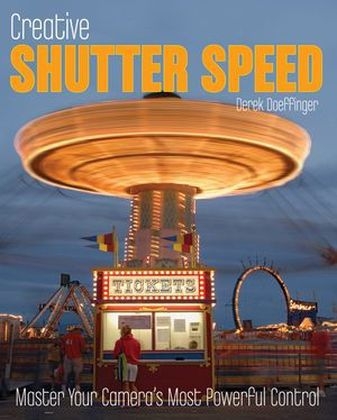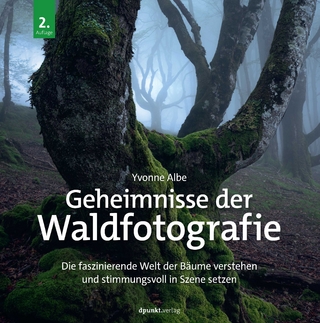
Creative Shutter Speed
John Wiley & Sons Ltd (Verlag)
978-0-470-45362-9 (ISBN)
- Titel ist leider vergriffen;
keine Neuauflage - Artikel merken
Derek Doeffinger, a former writer/photographer for Kodak, has been writing about digital photography since the first dSLR was introduced over 15 years ago. He is the author or co-author of ten how-to photography books and three scenic photo books: Waterfalls and Gorges of the Finger Lakes, Finger Lakes Splendor, and Waterfalls of the Adirondacks and Catskills.
Chapter 1 Tap the Power of Every Shutter Speed. 1/8000 Second-the shutter speed of NASA. 1/4000 Second-the shutter speed of NASCAR. 1/2000 Second-the optimal fast shutter speed. 1/1000 Second-a former record holder. 1/500 Second-a nostalgic favorite. 1/250 Second-the all-purpose shutter speed. 1/125 Second-for the scenic shooter. 1/60 Second-when the light dims it shines. 1/30 Second-the optimal slow shutter speed. 1/15 Second-where subjects blur themselves. 1/8 Second-the blessing of the blur. 1/4 Second-the poet laureate of motion pictures. 1/2 Second-where writing with light becomes reality. 1 Second-breaking the time barrier. 1 Minute-reenact exposures of the "ancients". 8 Hours-put your camera on the "C" shift. Nano Time-the hidden world of ultra-speed electronic flash. Chapter 2 Understanding Shutter Speed and Exposure. How the shutter works. About exposure. Camera controls for regulating exposure. From good to great exposure. Anatomy of a good exposure. Anatomy of a bad exposure. ISO setting-your secret weapon. Determining the correct exposure. Matching metering modes to scenes. Center-weight. Averaging. Matrix. Spot. Evaluating pictures as you take them. Evaluating visual image quality on the LCD. Evaluating technical exposure with the histogram. Balancing shutter speed and depth of field. Equivalent exposure values. Finding a way to get the shutter speed you want. White balance. Exposure rules of thumb. Adjusting exposure for light type. Adjusting exposure for tricky lighting conditions. Front lighting. Sidelighting. Backlighting. Extra-bright subjects. Extra-dark subjects. Chapter 3 How I Took These Pictures. County Fairs-Mania on the Midway. Curtains Lifted by a Summer Breeze. Swimmers-Half-Triathlon. Stunt Rider at the State Fair. Perfect Timing for the Perfect Pose. The Planned Picture. Boredom-the Great Creation Motivator. Luck, Not Skill. Everyday Life-in Peru. Balloons Away. Chapter 4 Tools and Controls to Exploit Shutter Speed. The camera you need is a dSLR. But let a snapshot camera tag along. Controls that put you in the right mode. Exposure modes. ISO control. Exposure compensation. Bracketing mode. Focus controls. Single Servo focus mode. Continuous Servo focus mode. Manual focus mode. Trap focus mode. Rapid picture-taking. File format. Mirror lockup and exposure delay. Accessories for motion techniques. Lenses. Sport lenses. Image-stabilized lenses. Neutral density filters. Polarizing filters. Memory cards. Monopods and tripods. Shutter release devices. Electronic flash. Image-adjustment software. Chapter 5 Stopping the Action. Everyday shutter speeds. Fast shutter speeds. Timing your shots. Determining a stop-action shutter speed. Other variables important to stopping motion. Action sequences-the art of static action. Taking pictures from moving vehicles. Shutter speeds for sharp pictures while handholding the camera. How to fi nd your personal steadiness shutter speed. Testing handheld, non-image-stabilized lenses. Testing stabilized lenses. View the images in Photoshop. Taking sharp pictures at questionable shutter speeds. Handholding? Take lots of pictures. Fast. Use the RAW fi le format and underexpose. Pull out the stabilized lens. Find a perch to support your camera. Direction of action. Wait for the action to pause. Wait for peak motion. Chapter 6 Shake, Rattle, and Roll your Camera. Pantastic panning. The background of blur. Rev up the blur for expressionistic panning. A gallery of panning. Zooming. Camera and subject are still-everything else moves. Camera held still-subject in motion. Running, jumping, spinning, and twisting with the camera. Shooting blur shots from the car. Camera tossers-only centerfielders need apply. Composition on the fly. Improving composition when the action picks up. Low angle versus high angle. Composition-positioning the subject in the frame. Composition-sizing the subject. Composition and subject direction. Moving toward you. Crossing in front of you. Taking the diagonal route. Glossary. Index.
| Verlagsort | Chichester |
|---|---|
| Sprache | englisch |
| Maße | 186 x 232 mm |
| Gewicht | 644 g |
| Einbandart | Paperback |
| Themenwelt | Kunst / Musik / Theater ► Fotokunst |
| Sachbuch/Ratgeber ► Freizeit / Hobby ► Fotografieren / Filmen | |
| Mathematik / Informatik ► Informatik | |
| ISBN-10 | 0-470-45362-1 / 0470453621 |
| ISBN-13 | 978-0-470-45362-9 / 9780470453629 |
| Zustand | Neuware |
| Haben Sie eine Frage zum Produkt? |
aus dem Bereich


